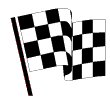Waving the flags and so much more – The marshals
* Mental note for 2015: Add something about the hybrid stuff and the problems they cause when recovering a driver - use of rubber gloves and such stuff * * Add also something about the reduction in marshal post as announced by the ACO from 1,600 to 1,200. “Posts” will disappear and there will now be “sectors”*
Little is known to many visitors about the marshals at Le Mans and their work, although there wouldn’t be any race at all without them. Marshalling is a hobby done by volunteers with a passion for motor sport. These men and women spend their free time and their own money to train in the many aspects of marshalling. They act as flag marshals, chief track marshals, pit lane marshals and there are many other roles. Their skills are crucial for the success of a race, because an exciting race can be destroyed by bad marshalling but it can also be made better and safer by good work from the marshals, even saving a driver’s life. The set of skills which is required is large and the willingness to attend training on a regular basis is an important prerequisite. Training covers fire fighting, flagging, observing, radio communication and many other topics.
There are many types of jobs to be done at any race meeting, and Le Mans is no different. The one thing which is noticeable is that, obviously, officials can’t be working for the whole 24 hours race plus the support event on the Saturday morning etc, so there would be enough for a minimum of 2 shifts, and the number is amazing, when you consider that the British Grand Prix at it’s height required approximately 1500 people for the weekend (that’s ALL jobs) so imagine how many for a circuit 3 times the size and a race meeting 4 times the length.
Some of the roles performed by the officials are:
Course/Flag/Observer, these are effectively the Race Directors ‘ground troops’. These three will work together on a post, the Course Marshal is the one you’ll see going out to an incident and working trackside, and reporting back to the Observer, who will report to Race Control what has happened. This is rather basic, as the Flaggie will be there waving the Blue, and reacting to what is required at that moment.
Pits, these Marshals will observe and report on all pit lane behaviour and stops. To do that requires a knowledge of the rules and regulations, no mean feat when you consider that they need eyes everywhere and will need to react quickly, nimble feet are needed in the lane to see all, but avoid being in the way.
From the information flowing into Race Control from all the Marshal’s post’s it is then up to the Control room people to filter out any important information that the Race Director may need to know and act upon, for example the release of the Safety Car (there are 2 or 3 around the track) who will be informed where the Race leader is and will try to pick him up (sometimes easier said) and if the leader is mired in the SC pack, when to ‘release’ the cars between the SC and leader. To do that, the SC that has the Race Leader behind will ‘wave by’ any cars between him and the Leader, these cars will then proceed to the tail of the next queue. Once the cars are ordered, everyone is happy, the SC’s will pull off, Green Flag will be shown to the Race Lead at the start line, and racing will re-commence
Following are the flags you’ll see over the race weekend and their meaning.
 The solid yellow flag requires drivers to slow down due to a hazard on the track.
The solid yellow flag requires drivers to slow down due to a hazard on the track.
A yellow flag displayed at the starter's stand or a marshal station indicates that there is a hazard downstream of the station. The manner of display depends on the location of the hazard:
- A single stationary flag denotes a hazard off the course
- A single waved flag denotes a hazard on the racing surface itself
- Two flags waved simultaneously denotes a hazard that wholly or partly blocks the racing surface. This informs the driver that there may be marshals on the track and to prepare to stop, if necessary.
 Red flags can only be waived upon instruction of the race director. When a race or a practice session is “red flagged” it is stopped due to some condition that has made the track unraceable. Typical conditions are accidents, weather problems or surface problems like too much oil or debris on the track. As soon as a red flag is shown, drivers must slow down and either stop or come back to the pits, overtaking is not permitted.
Red flags can only be waived upon instruction of the race director. When a race or a practice session is “red flagged” it is stopped due to some condition that has made the track unraceable. Typical conditions are accidents, weather problems or surface problems like too much oil or debris on the track. As soon as a red flag is shown, drivers must slow down and either stop or come back to the pits, overtaking is not permitted.
 The green flag is quite similar to green traffic light and simply means “Go!”. It can be waved by the starter to indicate the beginning of a race or practice session. Most typically it will be waved after a caution to tell the drivers that the race has been restarted and to indicate that the racetrack is clear of any obstacles or debris.
The green flag is quite similar to green traffic light and simply means “Go!”. It can be waved by the starter to indicate the beginning of a race or practice session. Most typically it will be waved after a caution to tell the drivers that the race has been restarted and to indicate that the racetrack is clear of any obstacles or debris.
 The yellow / red flag is commonly known as the “oil flag”, this flag indicates that there is a problem with, or change in, the surface ahead, like oil or water on the track.
The yellow / red flag is commonly known as the “oil flag”, this flag indicates that there is a problem with, or change in, the surface ahead, like oil or water on the track.
 The blue flag indicates to the driver that there is a quicker car following and about to pass him:
The blue flag indicates to the driver that there is a quicker car following and about to pass him:
- When held motionless, this is an indication to a driver that there is a faster car following closely behind, but not yet close enough for a pass.
- A waived blue flag indicates that the driver is about to be overtaken and should take care to permit the following vehicle a safe pass.
 The black flag generally means that there has been an infraction of the rules and the driver, to whom that flag is shown must bring the car to the pits. It is usually displayed along with a pit board listing the driver's car number
The black flag generally means that there has been an infraction of the rules and the driver, to whom that flag is shown must bring the car to the pits. It is usually displayed along with a pit board listing the driver's car number
 Without doubt the best know race flag, it is waved for all cars to indicate the finish of the race or a practice session.
Without doubt the best know race flag, it is waved for all cars to indicate the finish of the race or a practice session.
 Last warning to a driver before a black flag is shown to him, similar to the yellow card in football. It is usually displayed along with a pit board listing the driver's car number.
Last warning to a driver before a black flag is shown to him, similar to the yellow card in football. It is usually displayed along with a pit board listing the driver's car number.
 Black with an orange circle: information to a driver that his/her vehicle has a problem and that a pit stop must be made, is usually displayed along with a pit board listing the driver's car number.
Black with an orange circle: information to a driver that his/her vehicle has a problem and that a pit stop must be made, is usually displayed along with a pit board listing the driver's car number.
 Slow Vehicle on the track ahead, be it a car limping back to the pits, or during a caution period it could mean there is a breakdown truck on the track
Slow Vehicle on the track ahead, be it a car limping back to the pits, or during a caution period it could mean there is a breakdown truck on the track
 Not a flag, it’s a board which will be shown together with the yellow flag to inform the drivers that a safety car is on the track
Not a flag, it’s a board which will be shown together with the yellow flag to inform the drivers that a safety car is on the track
 The French flag, the Tricolore, is traditionally waived by a VIP at the starters post to get the race under way. In 2009, this duty was fulfilled by Fiat and Ferrari president Luca di Montezemolo to signify 60 years since Ferrari's first victory at Le Mans.
The French flag, the Tricolore, is traditionally waived by a VIP at the starters post to get the race under way. In 2009, this duty was fulfilled by Fiat and Ferrari president Luca di Montezemolo to signify 60 years since Ferrari's first victory at Le Mans.
Code 80 come to La Sarthe
In 2014 there was a new type of race neutralisation, Code 80. This has been seen under other names in other races, notably the Nurburg 24. It is a GPS based system that instantly advises the driver in car of Yellow Zone, at the same time the marshals will be waving their yellows, result is an 'instant Safety Car'. The field reduce their speed to 80kph and become essentially their own SC, no catching the car in front, this way the marshals can get to work and clear an incident much more quickly. Upon removal of the hold, the driver is instantly back to racing, no need to wait to pass a point on the track. The idea of this is to prevent losing time behind the Safety Car (deploy, catch the leader, pace, reorganise, release) this allows a pause rather than a suspension to racing.
2015 Marshalling changes
For 2015 there was a shake up for the on track marshals. Gone was the Poste system and in are Secteurs. This all in the name of safety, although the ACO have intimated that the overall numbers required are the same, a lot of the roles we are used to seeing at a track have been changed. The secteurs will be as per the attached map, gone is the old numbering system, no longer will the British Poste be at Poste 106 for the week, instead they will be part of Sector 29, and like other secteurs, will cover a larger part of track.
Since the 2014 race the ACO/Le Mans have invested in many track modifications, and with that change has come a change to how the marshals operate. From 2015, marshals will now be placed differently, old hands may see that marshals are now in different positions to what they remember, this is due to an increase in the number of flag marshals at more points. Each flag signal will be repeated on both sides of the track, hopefully this’ll ensure no signal is missed. The increase of flag points also means that any Code 80 called can be controlled easier, and smaller zones mean back to racing quicker.
What will be a significant, and major, change is in race neutralisation. After Max Bianchis terrible accident at Suzuka in 2014, gone are vehicle recoveries under yellow, Code 80 or Safety Car will be in place before anything happens – obviously this does not include urgent medical attention. This still means the marshals will be there first, but unlike now, there will be no crossing of the track to provide an initial assessment, but there will be no intervention until safe, and there will be more use of rapid intervention vehicles
Intervening with a Hybrid
On the side of the car next to the door are two lights, Green and Red, which indicate the state of the hybrid system. The simplest piece of advice given to the marshals at Silverstone with regard to an HY car with a hybrid failure, was “Don't touch it until you have spoken to Race Control/the team” Although the posts were issued with rather thick and heavy rubber gloves, the first thing to do was to call it to Race Control, after that a team member would arrive to ensure integrity of the system. Obviously should the car be in an accident, the priority is the driver, and he is sat in an isolated cell. However, there may be a time when extracting the driver is needed, in which case, out come the 'Marigolds' - very Heavy Duty latex gloves and a careful approach is taken. I am a pit marshal, so I can't say for sure what would happen on course, but the golden rule is if in doubt, do not touch.